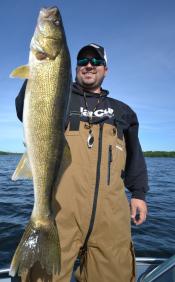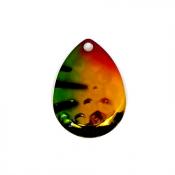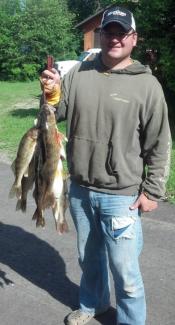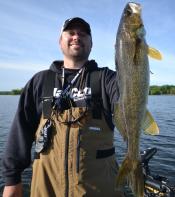 The past few weeks I’ve been fishing hard baits all over the place. Taildancers on Superior with Grant, Shad Raps on Pepin, and Max Raps on Rainy. All of which were a lot of fun, but more modern in terms of the timeline of my walleye fishing. This past weekend hearkened back to a sixteen year old kid and a 14 foot aluminum can for a boat, backtrolling windswept points in the north-central part of the state. Shoreline and adjacent structure was what you fished, unless you knew the lake well enough to find the few rock or gravel bars that infrequently dotted the lake bottom. Crawlers, leeches, or minnows were what you fished; put them in a walleye’s face long enough, and they’ll likely oblige. The best part is that the above still holds true today. Call me basic, call me crude, but I like me a good live bait bite up-north style about anytime I can fish it. There’s something so simple about it, yet can be so complex if you choose to take it there. Often, when the fish aren’t cooperating, your hand can be forced in that matter.
The past few weeks I’ve been fishing hard baits all over the place. Taildancers on Superior with Grant, Shad Raps on Pepin, and Max Raps on Rainy. All of which were a lot of fun, but more modern in terms of the timeline of my walleye fishing. This past weekend hearkened back to a sixteen year old kid and a 14 foot aluminum can for a boat, backtrolling windswept points in the north-central part of the state. Shoreline and adjacent structure was what you fished, unless you knew the lake well enough to find the few rock or gravel bars that infrequently dotted the lake bottom. Crawlers, leeches, or minnows were what you fished; put them in a walleye’s face long enough, and they’ll likely oblige. The best part is that the above still holds true today. Call me basic, call me crude, but I like me a good live bait bite up-north style about anytime I can fish it. There’s something so simple about it, yet can be so complex if you choose to take it there. Often, when the fish aren’t cooperating, your hand can be forced in that matter.
 This was the year I’d come prepared, with all kinds of live-bait that is, especially with some chubs. Like most folks, I love fishing with them, and hate paying for them. Not to mention, I like rigging the big ones. Not the 3-inch, barely-bigger-than-a-fathead variety bait shops will often charge $10-12/dozen for, but the mean, spike-nosed river variety you used to catch when you were a kid. These are chubs forged in the proving grounds of running water, where everything from snapping turtles to herons look to pick them off on a daily basis. Back in the day, a minnow seine and a few buddies was all it took to gather whatever minnows you’d want to use. Sometimes catching the bait is as fun as fishing with it, so I took my boys along to a small crick to share in the action. When it comes to collecting and keeping bait, boy have times changed. For the better that is. I used to have to hunt for the right river seine and minnow traps from mail order catalogs, hoping the size and construction was exactly what I needed, finding out often too-late that it was not. This year, I invested in a “system.” Several systems. Ways to keep bait longer term; to get the most bang for my buck for bait I paid for, and even more for what I caught myself. Being no stranger to collecting and storing bait, it isn’t about just keeping it. It’s about keeping it easier, longer, and better. From collection to deployment, I’m talking about a full system here.
This was the year I’d come prepared, with all kinds of live-bait that is, especially with some chubs. Like most folks, I love fishing with them, and hate paying for them. Not to mention, I like rigging the big ones. Not the 3-inch, barely-bigger-than-a-fathead variety bait shops will often charge $10-12/dozen for, but the mean, spike-nosed river variety you used to catch when you were a kid. These are chubs forged in the proving grounds of running water, where everything from snapping turtles to herons look to pick them off on a daily basis. Back in the day, a minnow seine and a few buddies was all it took to gather whatever minnows you’d want to use. Sometimes catching the bait is as fun as fishing with it, so I took my boys along to a small crick to share in the action. When it comes to collecting and keeping bait, boy have times changed. For the better that is. I used to have to hunt for the right river seine and minnow traps from mail order catalogs, hoping the size and construction was exactly what I needed, finding out often too-late that it was not. This year, I invested in a “system.” Several systems. Ways to keep bait longer term; to get the most bang for my buck for bait I paid for, and even more for what I caught myself. Being no stranger to collecting and storing bait, it isn’t about just keeping it. It’s about keeping it easier, longer, and better. From collection to deployment, I’m talking about a full system here.
 Leeches are easy. Hardy and tough, about all you have to do is keep them cool and change the water now and again. They keep in the fridge for storage in about any plastic container, but I found that the right system for me in the boat included a Frabill Crawler Can and Leech Bag for the livewell. The crawler can has an ice compartment below to help keep the leeches above it cool, and the bag gets those leeches acclimated to the water temperature and more active. Crawlers a bit tougher. Not only do they need cool and seem to be more temperature sensitive, but they need a bit of food to be kept over the summer. Learning from past trips, I never take my full summer supply. Rather, I keep the large worm storage system at home in the fridge, and use a medium sized Crawler Cabin with. Taking a tip from the good folks at Vados, I soak a paper bag in water, then put a small gel ice pack inside, wrapping it and stuffing it amongst the worm bedding. Worms stay cool like this for more than a full day, but that’s only necessary if a fridge isn’t available. For fishing with them in the boat, I utilize the Crawler Can, just as I do for leeches to keep bait cool and happy over the long haul, being sure to empty the contents of the Crawler Can back into the Crawler Cabin at the end of each day. The goal is to never take more bait onto the boat then is needed at any one time, thus minimizing the chance of losing your whole supply due to spilled containers, forgotten bait, losing it over the side of the boat…..don’t laugh, it’s all happened!
Leeches are easy. Hardy and tough, about all you have to do is keep them cool and change the water now and again. They keep in the fridge for storage in about any plastic container, but I found that the right system for me in the boat included a Frabill Crawler Can and Leech Bag for the livewell. The crawler can has an ice compartment below to help keep the leeches above it cool, and the bag gets those leeches acclimated to the water temperature and more active. Crawlers a bit tougher. Not only do they need cool and seem to be more temperature sensitive, but they need a bit of food to be kept over the summer. Learning from past trips, I never take my full summer supply. Rather, I keep the large worm storage system at home in the fridge, and use a medium sized Crawler Cabin with. Taking a tip from the good folks at Vados, I soak a paper bag in water, then put a small gel ice pack inside, wrapping it and stuffing it amongst the worm bedding. Worms stay cool like this for more than a full day, but that’s only necessary if a fridge isn’t available. For fishing with them in the boat, I utilize the Crawler Can, just as I do for leeches to keep bait cool and happy over the long haul, being sure to empty the contents of the Crawler Can back into the Crawler Cabin at the end of each day. The goal is to never take more bait onto the boat then is needed at any one time, thus minimizing the chance of losing your whole supply due to spilled containers, forgotten bait, losing it over the side of the boat…..don’t laugh, it’s all happened!
 Now onto chubs, the most challenging of all, to which I’ve employed a three part system. The first, is a collection device like a minnow trap or seine net. Hook and line catching works well too, but all should be utilized to get the most the fastest. The second part of the system is an Aqua-Life 6 gallon bait station. I looked for a way to do it better and cheaper but really can’t. These chubs need a good amount of water, and they need it to be well-aerated, which is even more true for shiners. That container has three options for power supply; a wall-mount plug, car cigarette lighter plug, and two resident D-cell batteries. There’s literally no excuse to not have constant aeration on these minnows. Daily water changes are also required to keep any volume of this bait, mostly due to all the ammonia and expelled stomach contents from these fish. They’re dirty little buggers, and you’ll kill them quicker than anything if you fail to do so. The final part of the system is different for every boat. Mine doesn’t keep bait cool enough and well-aerated enough in summer water temperatures, so for me it’s a Min-o-life personal baitstation. An admitted luxury, this third part is more about keeping your boat free of clutter. It literally fits about anywhere, stores a good amount of minnows, and has a built-in net to get them for you. You could also use the 6-gallon station, but it’s a bit more bulky, and again, this to me is about devising a system of components that work well in harmony.
Now onto chubs, the most challenging of all, to which I’ve employed a three part system. The first, is a collection device like a minnow trap or seine net. Hook and line catching works well too, but all should be utilized to get the most the fastest. The second part of the system is an Aqua-Life 6 gallon bait station. I looked for a way to do it better and cheaper but really can’t. These chubs need a good amount of water, and they need it to be well-aerated, which is even more true for shiners. That container has three options for power supply; a wall-mount plug, car cigarette lighter plug, and two resident D-cell batteries. There’s literally no excuse to not have constant aeration on these minnows. Daily water changes are also required to keep any volume of this bait, mostly due to all the ammonia and expelled stomach contents from these fish. They’re dirty little buggers, and you’ll kill them quicker than anything if you fail to do so. The final part of the system is different for every boat. Mine doesn’t keep bait cool enough and well-aerated enough in summer water temperatures, so for me it’s a Min-o-life personal baitstation. An admitted luxury, this third part is more about keeping your boat free of clutter. It literally fits about anywhere, stores a good amount of minnows, and has a built-in net to get them for you. You could also use the 6-gallon station, but it’s a bit more bulky, and again, this to me is about devising a system of components that work well in harmony.
Of course good bait, while extremely important, is just a facet of the bite. We employed a number of methods to get our fish, some more successful than others. The first was pulling spinners over scattered pods of fish along first shoreline breaks in 16-20FOW. Island breaks were particularly good, and where we found areas devoid of vegetation AND the wind was blowing, we caught fish on spinners in as shallow as 10 FOW. 2oz. bottom bouncers, paired with Jolly Roger Harnesses, and #3 blades in Seyka Perch, Firebelly, and Firetiger were the top producers. There’s a lot of bait perch in the system now from what we saw, and the Seyka Perch color did a great job imitating those young forage species. Rigging chubs was a good bet for primarily larger fish, and our best fish of each day came this way. 1/0 and larger hooks were key to working this presentation with the large chubs we were using, and shorter snells (approx. 3 feet) were used to keep these lively baitfish out of the rocks and weeds. A few stubborn spots were stacked with eater fish especially, and to get enough ‘eyes for the fry-pan, we often had to slow down and rig half-crawlers or leeches methodically along mid-lake reefs to get them. The weather was less than cooperative for almost the entire trip, with fairly calm and windless conditions for much of our time on the water, but there were fish to be had if you worked at them. Of course, “worked” is a relative term, and work those days seemed about as good as work gets.
Joel
Here’s a few more pics from the trip.
…and a few family ones.
Great Report Joel!
Looking forward to getting out on the water with you in the near future
Spinners for the eaters and rigging large chubs for big fish are the two things I remember best about fishing Leech. I need to get up there again soon. It looks like a great time!
It looks like a great time!
Nice work buddy!! I love the guitar shredding pic! Thats a keeper
I love the guitar shredding pic! Thats a keeper 
Ha Ha Ha HA !!!
I love your report and pictures…
The pic of your boy playing guitar is priceless !!!
Great info on the bait equipment tools.. I have a problem with keeping crawlers in the fridge.. Mama doesn’t like it when I find most of them in the head of lettuce..
Nice read and fish Joel!
Looks like a great time on Leech to me.
Great report Joel, i should really tie livebait on some day but cast retrieve cast retrieve is gettting to be such a fluid motion.
Nice report Joel – loaded with great info. on keeping bait fresh and the pics of the smiles are priceless!
– loaded with great info. on keeping bait fresh and the pics of the smiles are priceless! 
Great Report Joel